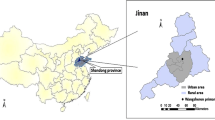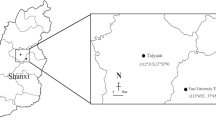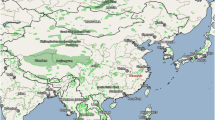Abstract
Ambient PM10 air samples were collected at two industrial sites and one urban residential site in the mining city of Panzhihua, China, from April, 2014, to January, 2015. Mass concentrations of ten trace metals (As, Cd, Cr, Ni, Co, V, Mn, Cu, Pb, and Zn) in PM10 were determined by inductively coupled plasma-mass spectrometry. The results showed Zn, Pb, Cu, Mn and V were the most abundant elements from the industrial sites. Concentrations for Cd, Cr, Co, Ni, Mn and Cu at industrial sites greatly exceeded the air quality standards of the World Health Organization and the Chinese Ministry of Environmental Protection. Principal component analysis indicated that the main sources of the trace metals were steel smelting, fuel combustion, geological and mineral dust. Four different clusters of particles (i.e., mineral, calcium-containing, soot and aluminosilicate) were identified by scanning electron microscopy coupled with energy dispersive X-ray spectrometry. Chromium (Cr) was found to present the highest excess cancer risk, implying the potential for carcinogenic health effects in local inhabitants. Manganese (Mn) presented a non-carcinogenic health risk to children and adults, while the other metals were within acceptable limits.


Similar content being viewed by others
References
Allen AG, Nemitz E, Shi JP, Harrison RM, Greenwood JC (2001) Size distribution of trace metals in atmospheric aerosol in the United Kingdom. Atmos Environ 35:4581–4591
Canepari S, Perrino C, Oliviero F, Astolfi ML (2008) Characterization of the traffic sources of PM through size-segregated sampling, sequential leaching and ICP analysis. Atmos Environ 42:8161–8175
Csavina J, Field J, Taylor M, Gao S, Landazuri A, Betterton E, Saez E (2012) A review on the importance of metals and metalloids in atmospheric dust and aerosol from mining operations. Sci Total Environ 433:58–73
Duan JC, Tan JH (2013) Atmospheric heavy metals and arsenic in China: situation, sources and control policies. Atmos Environ 74:93–101
Dubey B, Pal A.K, Singh G (2012) Trace metal composition of airborne particulate matter in the coal mining and non–mining areas of Dhanbad Region, Jharkhand, India. Atmos Pollut Res 3:238–246
EPA (1989) Risk assessment guidance for superfund. Volume I: human health evaluation manual (part A). US Environmental Protection Agency. EPA/540/1–89/002
GB3095-2012 (2012) Ambient air quality standards (in Chinese). Ministry of Environmental Protection of the People’s Republic of China
Heidam NZ (1982) Atmospheric aerosol factor, mass and missing data. Atmos Environ 16(8):1923–1931
Huang YM, Wei HP, Zhang YM (2009) Source analysis of heavy metals in PM10 of Wu Song district in Shanghai. Environ Sci Technol 32(1):130–133
Khodeir M, Shamy M, Alghamdi M, Zhong M, Sun H, Costa M, Chen L.C, Maliejczyk P (2012) Source apportionment and elemental composition of PM2.5 and PM10 in Jeddah city, Saudi Arabia. Atmos Pollut Res 3:331–340
Kitani S, Silva NR, Morita Y (1998) Global environmental pollutant substance vanadium activates mast cells and basophils at the late phase in the presence of hydrogen peroxide. Environ Toxicol Pharmacol 6:1–12
Kong SF, Lu B, Ji YQ, Zhao XY, Chen L, Li ZY, Han B, Bai ZP (2011) Levels, risk assessment and sources of PM10 fraction heavy metals in four types dust from a coal-based city. Microchem J 98:280–290
Lim JM, Lee JH, Moon JH, Chung YS, Kim KH (2010) Airborne PM10 and metals from multifarious sources in an industrial complex area. Atmos Res 96:53–64
Lv WW, Wang YX, Querol X, Zhang XG (2006) Geochemical and statistical analysis of trace metals in atmospheric particulates in Wuhan, central China. Environ Geol 51:211–132
Manoli E, Voutsa D, Samara C (2002) Chemical characterization and source identification/apportionment of fine and coarse air particles in Thessaloniki, Greece. Atmos Environ 36:949–961
Mansha M, Ghauri B, Rahman S, Amman A (2012) Characterization and source apportionment of ambient air particulate matter (PM2.5) in Karachi. Sci Total Environ 425:176–183
Moreno T, Querol X, Alastuey A, Viana M, Salvador P, de la Campa AS, Artinano B, de la Rosa J, Gibbons W (2006) Variations in atmospheric PM trace metal content in Spanish towns: illustrating the chemical complexity of the inorganic urban aerosol cocktail. Atmos Environ 40:6791–6803
Samara C, Kantiranis N, Kollias P, Planou S, Kouras A, Besis A, Manoli E, Voutsa D (2016) Spatial and seasonal variations of the chemical, mineralogical and morphological features of quasi-ultrafine particles (PM0.49) at urban sites. Sci Total Environ 553:392–403
Slezakova K, Pires JCM, Pereira MC, Martins F, Alvim-Ferraz MC (2008) Influence of traffic emissions on the composition of atmospheric particles of different sizes—part 2: SEM-EDS characterization. J Atmos Chem 60:221–236
Sonia C, de la Rosa JD, de la Campa AMS, González-Castanedo Y, Fernández-Caliani JC, Gonzalez I, Romero A (2013) Contribution of mine wastes to atmospheric metal deposition in the surrounding area of an abandoned heavily polluted mining district (Rio Tinto mines, Spain). Sci Total Environ 449:363–372
Sun Y, Zhuang G, Wang Y, Han L, Guo J, Dan M, Zhang M, Wang Z, Hao Z (2004) The air-borne particulate pollution in Beijing—concentration, composition, distribution and sources. Atmos Environ 38:5991–6004
Tan DB (2005) Study of air pollution feature and source judgment of Panzhihua city. J Panzhihua Univ 4:110–114
Tan JH, Duan JC (2013) China’s atmospheric particulates and heavy metal pollution sources and control suggestions. JGSCAS 30:146–148
Taus N, Tarulescu S, Idomir M, Taus R (2008) Respiratory exposure to air pollutants. J Environ Ecol 9:15–25
Thomaidis NS, Bakeas EB, Siskos PA (2003) Characterization of lead, cadmium, arsenic and nickel in PM2.5 particles in the Athens atmosphere, Greece. Chemosphere 52(6):959–966
Tian HZ, Lu L, Cheng K, Hao JM, Zhao D, Wang Y (2012) Anthropogenic atmospheric nickel emissions and its distribution characteristics in China. Sci Total Environ 417:148–157
U.S Environmental Protection Agency (EPA) (2011) Exposure Factors Handbook. National Center for Environmental Assessment, Washington, DC; EPA/600/R-09/052F. Available from the National Technical Information Service, Springfield, VA
Wang JQ, Sun ML, Li SL, Zhu ZH (1985) Assessment of atmospheric pollution and effect of human health risks. Sichuan Environ 4(4):12–23
WHO (2002) World health report. Reducing health risks, promoting health life. World Health Organization, Geneva
WHO (World Health Organization) (2000) Guideline for air quality. World Health Organization, Geneva
Wu T, Lan CY (2004) Vanadium and its effects on human health in the environment. Trace elements in Guangdong. Science 11(1):11–13
Xu OY, Yan WY, Wang XR, Tang SB, Lu XH, Zhao YF (1984) Distribution characteristics of heavy metals in the atmosphere in Dukou city. Environ Chem 3(5):35–42
Xue YH, Wu JH, Feng YC, Dai L, Bi XH, Li X, Tang Z, Tang SB, Chen MF (2010) Sources characterization and apportionment of PM10 in Panzhihua, China. Aerosol Air Qual Res 10 367–377
Zheng N, Liu JS, Wang QC, Liang ZZ (2010) Heavy metal exposure of children from stairway and sidewalk dust in the smelting district, Northwest of China. Atmos Res 44(27):3239–3245
Zhou SZ, Yuan Q, Li WJ, Lu YL, Zhang YM, Wang WX (2014) Trace metals in atmospheric fine particles in one industrial urban city: spatial variations, sources, and health implications. J Environ Sci 26:205–213
Zou BF, He ZY (1993) Environmental chemistry of vanadium. Environ Pollut Ctrl 15:26–31
Acknowledgements
This study was supported by the special State International Cooperation Plan (2013DFA21690) and the National Natural Scientific Foundation of China (41273124).
Author information
Authors and Affiliations
Corresponding author
Rights and permissions
About this article
Cite this article
Cheng, X., Huang, Y., Long, Z. et al. Characteristics, Sources and Health Risk Assessment of Trace Metals in PM10 in Panzhihua, China. Bull Environ Contam Toxicol 98, 76–83 (2017). https://doi.org/10.1007/s00128-016-1979-0
Received:
Accepted:
Published:
Issue Date:
DOI: https://doi.org/10.1007/s00128-016-1979-0




